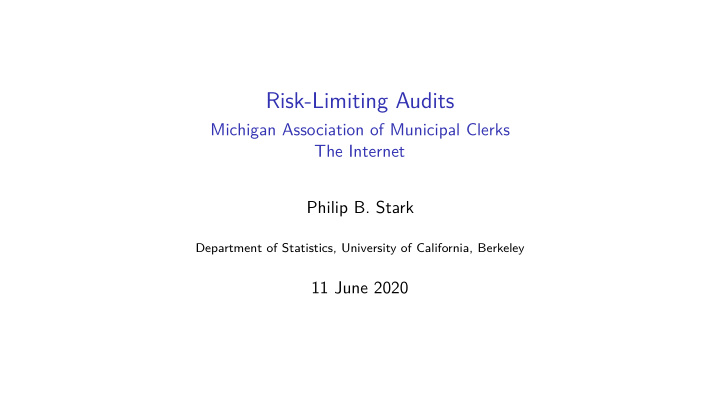



Risk-Limiting Audits Michigan Association of Municipal Clerks The Internet Philip B. Stark Department of Statistics, University of California, Berkeley 11 June 2020
Why audit?
Why audit? ◮ Any way of counting votes can make mistakes ◮ Every electronic system is vulnerable to bugs, configuration errors, & hacking ◮ Did error cause losing candidate(s) to appear to win?
Did reported winner(s) really win?
Did reported winner(s) really win? ◮ If there’s a reliable, voter-verified paper trail, can check ◮ Usually don’t need to look at many ballots ◮ To tell whether soup is too salty, don’t have to drink the whole pot—or even 10%: stir, then taste a tablespoon ◮ Too much salt in soup is like too much error tabulating votes ◮ Stirring, then tasting a tablespoon is like checking a random sample of ballots
Why dice?
Why dice? ◮ Ensures nobody can predict which ballots will be audited ◮ Ensures that the mathematics of auditing really applies: every ballot card has the same chance of being audited ◮ Ritual with public participation helps build trust ◮ Could use other methods: bingo balls, coin tosses, card cutting, etc., but dice are cheap, easy to get, easy to use, and easy to check for tampering
Checking equipment v. checking outcomes
Checking equipment v. checking outcomes ◮ Sterile scalpel v. patient’s condition ◮ Checking outcomes should be routine ◮ No matter how big the margin, need some checking ◮ May avoid contentious recounts ◮ Vote once, count a bit more than once, certify once
What’s special about RLAs?
What’s special about RLAs? An RLA has a big, known chance of correcting the reported outcome if the reported outcome is wrong. Risk limit is the largest possible chance that, the audit won’t correct the reported outcome if the reported outcome is wrong. ◮ If risk limit is 5%, then if the outcome is wrong, there’s a 95% chance the RLA will correct it ◮ Accuracy standard: did reported winner(s) really win? ◮ Only checks tabulation : assumes that the paper trail is trustworthy
How much auditing do we need?
How much auditing do we need? At least enough to be confident who won. (Maybe don’t need accuracy to the last vote.) ◮ Starting sample size doesn’t matter ◮ What matters is when you stop auditing ◮ Don’t stop until there’s convincing evidence the reported outcome is right
Example: Check the claim that a coin is biased in favor of heads
Example: Check the claim that a coin is biased in favor of heads ◮ Toss 5 times, get HHHHH ◮ Only 3% chance that would happen if the coin is fair; even lower if coin favored tails ◮ Therefore, strong evidence coin favors heads ◮ Just like checking whether reported winner really won
Requirements
Requirements ◮ Voter-verified paper trail ◮ Any jurisdiction with paper can do an RLA ◮ Some voting equipment makes it easier , but replacing equipment isn’t necessary ◮ “Ballot manifest”: description of how ballots are stored ◮ Should be routine ◮ “It’s the day after the election. Do you know where your ballots are?” ◮ Manually inspect random sample of paper ballots ◮ individual ballots, batches, unstratified, stratified, w/ or w/o replacement ◮ polling audits: just need ballots ◮ comparison audits: also need to export data from voting system & check totals
Pilots (since 2008–I’ve probably missed some)
Pilots (since 2008–I’ve probably missed some) Alaska : statewide California : Alameda, Humboldt, Inyo (2), Madera, Marin (2), Merced, Monterey, Napa, Orange (3), San Luis Obispo, Santa Cruz, San Francisco, Stanislaus, Ventura, Yolo (2) Colorado : Arapahoe, Boulder, others; now routine statewide Georgia : Bartow Indiana : Marion Michigan : Kalamazoo, Lansing, Rochester Hills New Jersey : Essex, Gloucester, Union Ohio : Cuyahoga Pennsylvania : Philadelphia Rhode Island : Bristol, Cranston, Portsmouth Virginia : Fairfax Wyoming : statewide Denmark
Evidence and Trustworthiness
Evidence and Trustworthiness An audit can’t be better than the paper trail it uses. ◮ No paper trail, no audit ◮ If paper trail not voter-verified (e.g., VVPAT, BMDs), can’t verify winner ◮ If paper trail untrustworthy, audited outcome untrustworthy
5 Cs
5 Cs ◮ Create durable, trustworthy record of voter intent ◮ ideally, hand-marked paper ballots with BMDs for voters who benefit from them ◮ Care for the paper record ◮ verifiable chain of custody, 2-person custody rules, ballot accounting, good seal protocols, etc. ◮ Compliance audit: establish whether paper trail is trustworthy ◮ ballot accounting, including VRDB, pollbooks, etc.; check chain of custody logs, video, etc.; eligibility ◮ Check reported outcome against the paper by auditing ◮ Correct the reported outcome if it is wrong
Recommend
More recommend